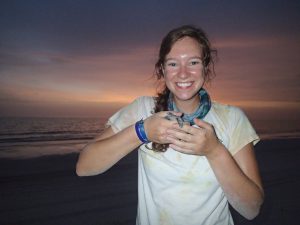
To many friends, family members, and acquaintances, I am “the turtle girl”. Since 2012, I have been gifted with everything from turtle earrings to turtle socks to a turtle trivet. And I love all of these gifts! Because I really and truly do love sea turtles. However, I am not actually a sea turtle biologist. But I did spend two summers as a sea turtle intern in southwest Florida. These two summers changed my outlook on life, my level of respect for sea turtle biologists, and my sense of self. Studying sea turtles is not all rainbows and butterflies like many might think. It’s not all selfies with cute hatchlings. When those days happen, you feel a true sense of euphoria. But that’s only because many of the other days are not that easy.
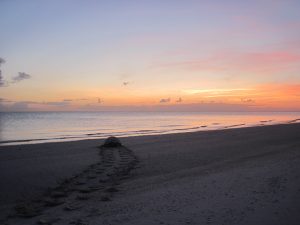
Now maybe these experiences were so formative for me because of the phase of life I was in when I undertook them (23-25 years old and still searching for so many things in the world), but I think they would affect anybody. I came away more confident in my ability to handle everything from emotional hardships to emergencies, stronger of stomach and will, more keenly aware of the ups and downs of life, and even more in awe of the beauty, ferocity, and resilience of nature and especially of the ancient charismatic megafaunal creature that is the sea turtle. The sea turtle life is not easy but it is that defiance of difficulty, that grace under pressure, and strength of determination in the face of the unknown that will continue to inspire me.
Please note, the following anecdotes apply to sea turtle research and conservation conducted with proper permits and only during sea turtle nesting season. The stories only apply to my experience within the United States working primarily with loggerheads. There are areas where sea turtle nest conservation is far more dangerous for other reasons, such as poaching which can lead to violence against those on beach patrol. My experience in no way represents everyone’s. I simply want to offer a window into a world few have an opportunity to experience. And finally, this is going to sound like a lot of complaining, but if you read through to the end, you might be surprised.
Here are some things you should know about what it’s like to study sea turtles:
1) The Hours (aka Stump Turtles and Those that Glow)
Whether you survey the beach in the wee hours of the morning to check for nests or you’re out on the beach all night, exhaustion is a reality.
On many beaches, especially those in populated areas, morning surveys must be completed early so beach rakers can smooth the sand. So you’re up and on the beach as the light begins creeping over the horizon and well before the sun makes an appearance. To be fair, it’s a beautiful and very peaceful time of day and it hopefully means your work is finished before it gets too hot.
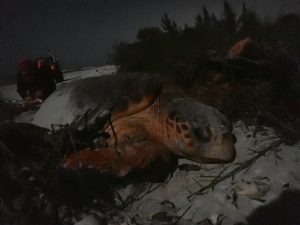
When you’re out at night, you go nocturnal, which turns you all upside down. You find yourself waking up at 4 pm, eating cereal while doing data entry from the night before, heading out to the beach to get set up and ready for the night around 6:30/7 pm, working all night, returning anytime between 5 am and 9 am, showering, writing up the night’s notes in a journal (because you will forget otherwise) and eating dinner and maybe drinking a beer at those hours, and then going to bed between 7 and 10 am. It gets confusing. And you lose track of dates easily. And for many, being nocturnal makes you loopy. I’d often get tricked by “stump turtles” while driving the ATV up and down the beach. Any dark shape—such as tree stumps—suddenly looks like a turtle. Luckily, the stumps don’t move, so eventually you realize it’s not a turtle. And I’ll never forget the night one of the other interns looked me earnestly in the face while we were working up a nesting mama and asked (to paraphrase) “Am I tripping from exhaustion or is that turtle glowing?” To be fair, the turtle’s carapace would glow when touched due to the presence of bioluminescent critters clinging to it.
2) The Blood [aka “Dig a Little Deeper”]
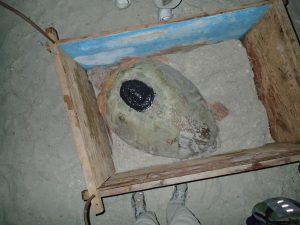
Sometimes, the turtle bites you. No, I’m not joking. Luckily I have not personally had that experience, but one of my supervisors did. Turtles are FIESTY. And they are strong. A nesting mama is a very determined creature and one not to be crossed. One night while attempting to stop a loggerhead from returning to the ocean after nesting so that we could attach a satellite tag to her, my supervisor got in her way and she bit his ankle. Now, we did stop her, put a box around her, and attached a satellite tag, but I don’t think she’s on the list of his favorites.
We bled for other reasons too. The beaches I worked on had large raccoon populations that made it a habit to depredate (prey upon) the nests after they were laid. To prevent this, we’d cage the nests with wire mesh cages. Accidentally cutting myself when building a cage, getting blisters from digging in the sand so the cage could be anchored below the surface, and digging in the sand/shell hash to find the clutch all tended to lead to some bloodshed. Not all sand is fluffy. In southwest Florida, many beaches have a very high shell fragment content and many of these shells are sharp! In order to properly center a cage over a nest, you had to know precisely where the clutch (or cluster of eggs) were. So regardless of whether you watched mama lay the eggs or you found the nest the next morning, you’d have to dig through the sand and shell to find the eggs. And sometimes, turtles leave behind quite a mess and it’s hard to know where they are within the tracks left behind. So you dig and you dig… Those summers, I replayed “Only Way I Know” by Jason Aldean over and over in my head [“You get tired and you don’t show it. Dig a little deeper when you think you can’t dig no more. That’s the only way I know”].
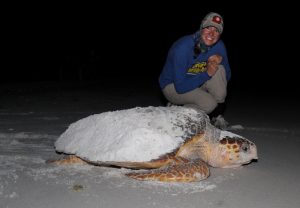
And the final but most prevalent cause of blood loss: insects. Mosquitos and No-see-ums were everywhere. Swarms. We were out on those beaches like fashion-impaired ninjas. We wore long-sleeves (often two layers), long pants (again often two layers), long socks (into which we’d tuck our pants), buffs (covering our faces, ears, and necks), and hats. The goal was to only have the area immediately around your eyes uncovered. And it wasn’t uncommon to find these bugs in our snot when we’d blow our noses or in the corners of our eyes.
3) The Sweat
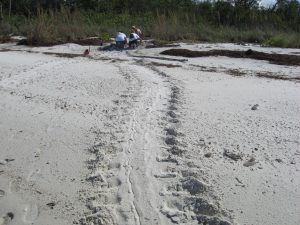
If you couldn’t tell from the previous passages, this sort of work requires intense physical labor. Walking long stretches of beach in the Florida sun is sweaty and draining work. Add to that digging in the sand, building cages, cutting the wire mesh to create cages, digging 1 ft. deep and 1 ft. wide trenches for each side of the cage to sit down in through roots, shell, and sand… let’s just say, lots of clothes got soaked through (especially all those night-time layers) and I lost a lot of weight both of these summers.
4) The Tears
A. Of Sorrow
After all the hours of labor, the loss of sweat and blood, you’d like to think that all the nests incubate well and hundreds of turtles hatch and make it to the ocean to grow up. Ignoring the estimate that only 1 in every 1000 hatchlings make it to adulthood is hard enough. But sometimes things don’t go that smoothly.
Sea turtle nests and hatchlings are an attractive source of nutrition for everything from the aforementioned raccoons to coyotes, feral hogs, ghost crabs, birds, fire ants, and even plants. Those ~100 loggerhead eggs per clutch are a jackpot for these creatures. You’d see a nesting mama work her way into the dune vegetation, high up the beach, and think, “good! That nest is way above the inundation line”. But then after 80 days (nests generally hatch around 60 days after being laid and at 80, protocol dictates digging them up to assess them), you open up a nest and find the roots of dune plants have grown into these eggs and sucked them dry. Or one morning, you come upon tiny sea turtle tracks in the sand leaving on of the nests, but not all of these tracks make it to the water line. You find hatchlings covered in fire ants, some still desperately trying to escape but clearly weakening and others already gone. You throw on some gloves, grab a bucket, and quickly dig out as many remaining hatchlings from the nest as possible and rinse the ants off. But you can’t save them all.
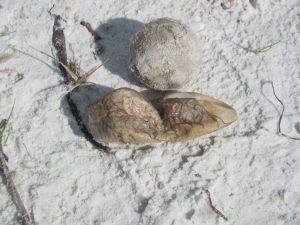
Speaking of inundation… Do you remember that 60 days from laying to hatching I mentioned? Well, my first summer interning and monitoring beaches, that timing was acutely painful. That summer, the Gulf of Mexico side of Florida was drenched by Tropical Storm Debby in June, just before any of nests were ready to hatch. Then, Hurricane Isaac showed up about 2 months later. The rains and storm surges from these storms drowned the sea turtle eggs inside the nests. Debby got the first bunches and Isaac got pretty much everyone after that. So even thought turtles lay multiple clutches each year, very few made it that year. I had certainly less than 10 nests hatch successfully, some of which only hatched partially. I remember being thrilled when finding one that had 5 eggs out of the whole clutch hatch. Most of my nests that summer were 80-dayers. We’d dig them up 20 days after their due date, count the eggs, open them and if possible record the stage of turtle development they’d reached. Sometimes they were too rotten for that. And all of them smelled. There’s nothing quite like that smell and it doesn’t come off you. There were days I had trouble eating that summer (again, contributing to some of that weight loss…). And to be truthful, there were days when we’d do these, open up eggs that contained embryos so very close to being fully developed but dead before they could hatch, that I did cry. And there were days where I almost threw up from the smell. But I have a strong stomach. And I think it’s all the stronger now.
B. Of Joy and Relief
Now, for those of you who have born with me this far, you may be wondering why on earth I’d do this for a second summer. And we’re arriving at that place now!
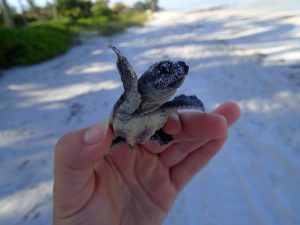
Amidst all the lost nests, including some that got washed out and never found again, there were those few that hatched that brought smiles to our faces and possibly some tears to our eyes. For finally, there were a few hatchlings joining the population of animals that captivate us! There’s nothing like coming upon a nest that has depressed (meaning, the eggs have hatched, the turtles have left, and the weight of the sand has caused it to collapse down/inward). Three days after finding a depressed nest (such a misnomer!), we’d excavate it. Those three days would allow any straggler hatchlings to make a natural exit if able. When we’d excavate, we’d occasionally find a few stragglers which we’d release later. And yes, seeing those hatchlings always meant pictures because they’re soooo cute! Holding one in your hand and it trying to swim away, flapping it’s flippers, is the absolute best way to start a day. And even if there were no stragglers, we’d pick through the eggshells to estimate the number that hatched. And those empty leathery shells held so much symbolism. They became a sign of hope and the beginning of a journey. There was truly light within the darkness, hope despite suffering, and smiles among tears.
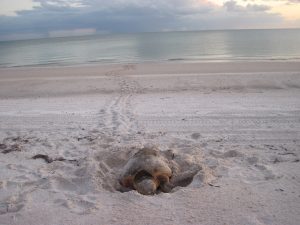
Truth be told, I’d never exchange those summers for anything! All the exhaustion, blood, sweat, and tears were worth it. There is little in the world as inspiring as watching a sea turtle mama haul herself up the sand beach, carefully select a location to lay her eggs (sometimes after a painfully long time and several abandoned egg chambers), and enter her trance while dropping sticky ping pong ball sized eggs into the hole she has dug. I know it doesn’t sound awe-inspiring, but it truly is. No one teaches them how to do this. It’s innate to their beings. You see mamas with scars, missing flippers, chunks of carapace missing, who engage in this test of determination. One of my favorite mamas we actually dubbed “Stumpie” because she was missing one of her rear flippers and therefore dug somewhat crooked nest chambers. But she dug anyway. And ever missing her one flipper, the portion still present would move to try to dig just the same as the other. I was honored to encounter these beauties and get to know some of them by name and nesting habits. For example, I never wanted to encounter Beatrice just as she came out of the water, because she was a slow nester, meaning, catching her early in the process meant patiently watching her and waiting with her for at least 2 hours, leaving the other intern with me that night to cover anything else that came up in the interim. She also tended to nest in dense vegetation. Emily nested quickly but generally in an area where the bugs were particularly bad. To have the opportunity to tag them, collect samples, attach satellite tracking tags to help find out where they forage, and learn about who it is that returns year in and year out was fascinating. It opened my eyes to the mysteries and questions and research world surrounding sea turtles, including the immense challenges in studying them. Whether you’re on night duty and seeing the turtles or not, you find yourself pulled into their world. And honestly, there’s very little as satisfying as locating a clutch in a pile of sand on the first try when you haven’t seen the turtle nest and only have the tracks and signs of nesting to guide you as to where the eggs may be buried.
The sea turtle conservation community is also one unlike anything I’ve ever experienced. There’s an immediate camaraderie and respect when you meet a fellow turtler, even if you worked on totally different beaches and projects. It’s also a surprisingly small community, so you’re bound to only have a few degrees of separation from any other turtler.
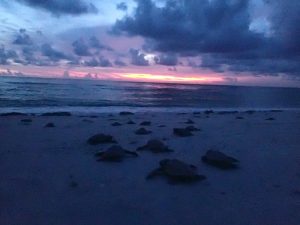
Another pro for this work is the beauty and majesty of nature. Seeing a sea turtle carapace glowing under a night full of stars, experiencing how bright a beach under a full moon is (and how unnecessary those ATV headlights are those nights), seeing innumerable sunrises and iridescent waters that come with them, feeling the terror but reverence for the power of nature while huddling under a beach house during a sudden thunderstorm or listening to the tropical storm force winds howling past the shack you’re spending the night in because it’s too dangerous to leave the island and then taking the ATV out to the beach when it clears and seeing how the topography has been reshaped by the waves and surge… these experiences are some I’ll value for the rest of my life.
I hope this provided a glimpse into the life of sea turtle research and conservation. Please feel free to ask any questions in the comments!
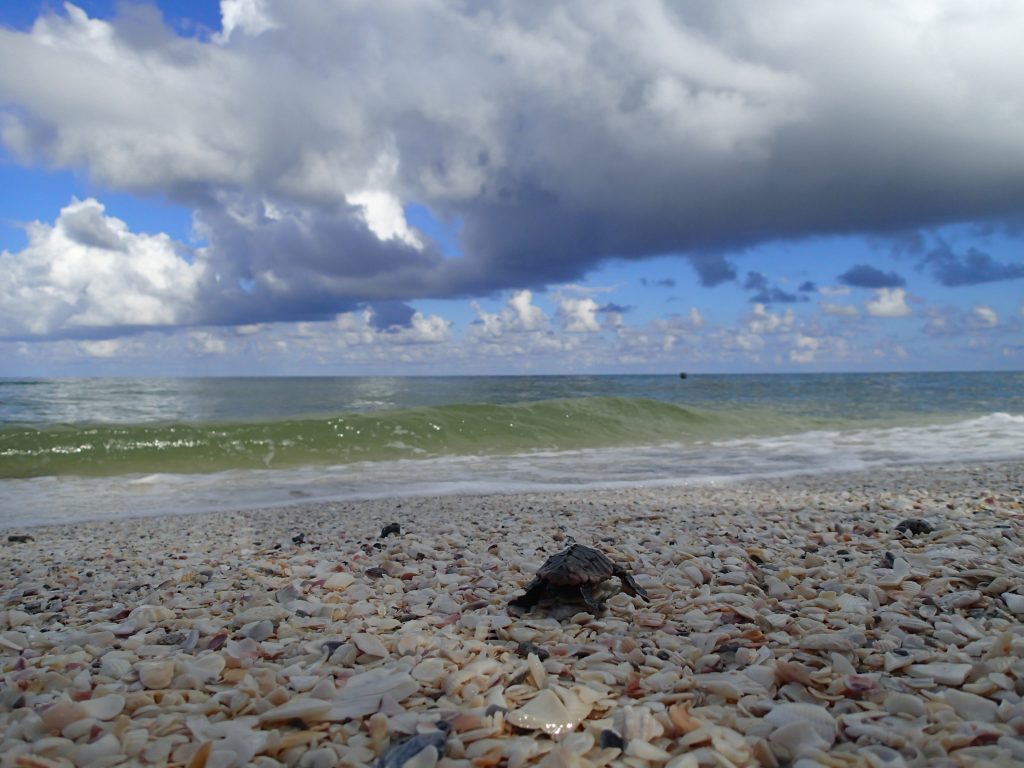
Podcast: Play in new window | Download
I am a graduate of the University of Notre Dame (B.S.) and the University of Rhode Island (M.S.). I now work in southwest Florida, contributing to the management of an estuary. I am fascinated by the wonders of nature, the land-sea interface, ecology and human disturbance (and solutions!). On a personal level, I am a chocoholic, love to travel and be outside, and relax by reading or spending time with my emotionally needy dogs!



